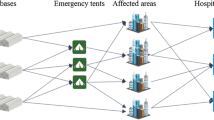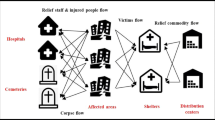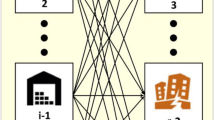Abstract
The disaster response routes play a crucial role in transporting injured people and goods during the 72 golden hours after disaster. These routes connect the major disaster relief centers. Prior identification of the disaster response routes for a city enables the response teams to reach the disaster locations quickly and conduct relief and rescue operations without being obstructed by the outbound flow of evacuees from the city. These routes should not generally be used by the public unlike the evacuation routes. In this paper, a multi-objective stochastic disaster response routes design problem is presented. In this study, with the goal of reducing vulnerability, the disaster response routes network can be protected against disaster scenarios to maintain its connectivity using more independent routes. An exact approach including a bounded objective function method for considering the multi-objective functions, including the network factors (OD connectivity, vulnerability, and management) and an exact method (branch-and-cut) for solving the proposed model are suggested. The results for Sioux-Falls and Tehran networks show the effectiveness of the model.
Similar content being viewed by others
Abbreviations
- A :
-
Set of all links of transportation network, a
- Ā :
-
Set of road links that are candidates of the network protection strategies, ā ⊂ A
- \(\rlap{-} A\) :
-
Set of suggested links, \(\rlap{-} a \subset A\)
- B :
-
Budget for the DRRsN protection
- b :
-
Budget plan, the fraction of the full network protection budget (B)
- C ̄a :
-
Protection cost, cost for protecting link ā
- c ̄a :
-
Retrofit percentage for candidate link ā
- \(C_{\rlap{-} a}\) :
-
Design cost, cost for adding suggested link \(\rlap{-} a\)
- \(cs_{\rlap{-} a}\) :
-
1 if suggested link \(\rlap{-} a\) is used, and 0 otherwise
- \(d_{od}^s\) :
-
Number of unconnected disaster response trips (o, d) under scenario s
- E a :
-
Maximum permitted number of paths traversing link a
- f ā :
-
Optimum protection level of link ā
- K :
-
Set of coverage points, kg ∈ K denotes the type of k)
- L :
-
Maximum allowable length for the DRRsN
- l a :
-
Length of link a
- M :
-
A large enough positive number
- N :
-
Set of all nodes, n
- N g :
-
Number of cover points with type g
- \(N_{od}^s\) :
-
Number of access routes that should provide multiple connections between each OD pair under scenario s
- OD :
-
Set of origin-destination, (o, d)
- P s :
-
Probability of scenario s
- \(p_{\bar{a}}^s\) :
-
Survival probability of link ā under scenario s
- \(\bar{p}_{\bar{a}}^s\) :
-
Survival probability of link ā under scenario s after allocating the protection cost
- \(q_{\bar{a}}^s\) :
-
Survival probability of link ā under scenario s after complete protection
- R :
-
Set of all routes, r
- S :
-
Set of all disaster scenarios, s
- T r :
-
Travel time of route r
- t a :
-
Travel time of link a
- \(w_a^s\) :
-
Number of paths traversing link a (path-link) under scenario s
- \(x_r^s\) :
-
1 if route r under scenario s is used, and 0 otherwise
- y a :
-
1 if link a is used, and 0 otherwise
- \(z_k^g\) :
-
1 if cover point k with type g is used, and 0 otherwise
- \(\delta_r^a\) :
-
Parameters for link-path incidence relationships. If link a is on route r, \(\delta_r^a=1\); otherwise \(\delta_r^a=0\).
- \(\delta_r^{od}\) :
-
Parameters for OD point-path incidence relationships. If route r connects point o to d, \(\delta_r^{od}=1\); otherwise, \(\delta_r^{od}=0\)
- \(\delta_a^k\) :
-
Parameters for cover point-link incidence relationships. If link a covers point, k \(\delta_a^k=1\); otherwise, \(\delta_a^k=0\)
- ∝ g :
-
Required coverage of points with type g
References
Abdelgawad H, Abdulhai B (2009) Emergency evacuation planning as a network design problem: A critical review. Transportation Letters 1(1):41–58, DOI: https://doi.org/10.3328/TL.2009.01.01.41-58
Akbari V, Salman FS (2017) Multi-vehicle prize collecting arc routing for connectivity problem. Computers & Operations Research 82:52–68, DOI: https://doi.org/10.1016/j.cor.2017.01.007
Anaya-Arenas AM, Renaud J, Ruiz A (2014) Relief distribution networks: A systematic review. Annals of Operations Research 223(1):53–79, DOI: https://doi.org/10.1007/s10479-014-1581-y
Babaei M, Shariat-Mohaymany A, Nikoo N, Ghaffari A-R (2019) A multi-objective emergency network design problem to carry out disaster relief operations in developing countries: A case study of Tehran, Iran. Journal of Humanitarian Logistics and Supply Chain Management 9(2):250–269, DOI: https://doi.org/10.1108/JHLSCM-12-2018-0081
Carpentier P, Cohen G, Chancelier J-P, de Lara M (2015) Stochastic multi-stage optimization. Springer, Basel, Switzerland, 5
Caunhye AM, Zhang Y, Li M, Nie X (2016) A location-routing model for prepositioning and distributing emergency supplies. Transportation Research Part E: Logistics and Transportation Review 90:161–176, DOI: https://doi.org/10.1016/j.tre.2015.10.011
Çelik M, Ergun Ö, Keskinocak P (2015) The post-disaster debris clearance problem under incomplete information. Operations Research 63(1):65–85, DOI: https://doi.org/10.1287/opre.2014.1342
Chandrashekaran S, Banerjee S (2014) Optimal Retrofit strategy for disaster resilience of highway bridges. 10th US national conference on earthquake engineering, July 21–25, Anchorage, AK, USA
Chu JC, Chen S-C (2015) Optimization of transportation-infrastructure-system protection considering weighted connectivity reliability. Journal of Infrastructure Systems 22(1):04015008, DOI: https://doi.org/10.1061/(ASCE)IS.1943-555X.0000264
City of Pitt Meadows (2013) Operational flood response plan. Pitt Meadows, British Columbia, Canada
Du L, Peeta S (2014) A stochastic optimization model to reduce expected post-disaster response time through pre-disaster investment decisions. Networks and Spatial Economics 14(2):271–295, DOI: https://doi.org/10.1007/s11067-013-9219-1
Edrissi A, Poorzahedy H, Nassiri H, Nourinejad M (2013) A multi-agent optimization formulation of earthquake disaster prevention and management. European Journal of Operational Research 229(1):261–275, DOI: https://doi.org/10.1016/j.ejor.2013.03.008
Faturechi R, Miller-Hooks E (2014) Measuring the performance of transportation infrastructure systems in disasters: A comprehensive review. Journal of Infrastructure Systems 21(1):04014025, DOI: https://doi.org/10.1061/(ASCE)IS.1943-555X.0000212
Hu F, Yang S, Hu X, Wang W (2017) Integrated optimization for shelter service area demarcation and evacuation route planning by a ripple-spreading algorithm. International Journal of Disaster Risk Reduction 24:539–548, DOI: https://doi.org/10.1016/j.ijdrr.2017.06.006
Hu X-B, Wang M, Ye T, Shi P (2016) A new method for resource allocation optimization in disaster reduction and risk governance. International Journal of Disaster Risk Science 7(2):138–150, DOI: https://doi.org/10.1007/s13753-016-0089-2
JICA (2004) The comprehensive master plan study on urban seismic disatser prevention and management for the greater tehran area. Tehran Disaster Mitigation and Management Center, Tehran, Iran (in Persian)
Joint Emergency Liaison Committee (2005) Operationalizing disaster response routes in british columbia. Phase 2 Working Group, British Columbia, Canada
Kasaei M, Salman FS (2016) Arc routing problems to restore connectivityof a road network. Transportation Research Part E: Logistics and Transportation Review 95:177–206, DOI: https://doi.org/10.1016/j.tre.2016.09.012
Khademi N, Balaei B, Shahri M, Mirzaei M, Sarrafi B, Zahabiun M, Mohaymany AS (2015) Transportation network vulnerability analysisfor the case of a catastrophic earthquake. International Journal of Disaster Risk Reduction 12:234–254, DOI: https://doi.org/10.1016/j.ijdrr.2015.01.009
Kongsomsaksakul S, Yang C, Chen A (2005) Shelter location-allocation model for flood evacuation planning. Journal of the Eastern Asia Society for Transportation Studies 6:4237–4252, DOI: https://doi.org/10.11175/easts.6.4237
Konu AS (2014) Humanitarian logistics: Pre-positioning of relief items in Istanbul. MSc Thesis, Middle East Technical University, Ankara, Turkey
Li X, Batta R, Kwon C (2017) Effective and equitable supply of gasoline to impacted areas in the aftermath of a natural disaster. Socio-Economic Planning Sciences 57:25–34, DOI: https://doi.org/10.1016/j.seps.2016.08.001
Lim Y, Rhee S (2010) An efficient dissimilar path searching method for evacuation routing. KSCE Journal of Civil Engineering 14(1):61–67, DOI: https://doi.org/10.1007/s12205-010-0061-4
Liu C (2009) A stochastic programming approach for transportation network protection. PhD Thesis, University of California, Davis, CA, USA
Miettinen K (2012) Nonlinear multiobjective optimization. Springer Science & Business Media, New York, NY, USA, 85–87
Negarestani A, Namvaran M, Shahpasandzadeh M, Fatemi S, Alavi S, Hashemi S, Mokhtari M (2014) Design and investigation of a continuous radon monitoring network for earthquake precursory process in Great Tehran. Journal of Radioanalytical and Nuclear Chemistry 300(2):757–767, DOI: https://doi.org/10.1007/s10967-014-3020-6
Ng M, Park J, Waller ST (2010) A hybrid bilevel model for the optimal shelter assignment in emergency evacuations. Computer-Aided Civil and Infrastructure Engineering 25(8):547–556, DOI: https://doi.org/10.1111/j.1467-8667.2010.00669.x
Nikoo N, Babaei M, Mohaymany AS (2018) Emergency transportation network design problem: Identification and evaluation of disaster response routes. International Journal of Disaster Risk Reduction 27:7–20, DOI: https://doi.org/10.1016/j.ijdrr.2017.07.003
Özdamar L, Ekinci E, Küçükyazici B (2004) Emergency logistics planning in natural disasters. Annals of Operations Research 129:217–245, DOI: https://doi.org/10.1023/B:ANOR.0000030690.27939.39
Peeta S, Sibel Salman F, Gunnec D, Viswanath K (2010) Pre-disaster investment decisions for strengthening a highway network. Computers & Operations Research 37(10):1708–1719, DOI: https://doi.org/10.1016/j.cor.2009.12.006
Rivera-Royero D, Galindo G, Yie-Pinedo R (2016) A dynamic model for disaster response considering prioritized demand points. Socio-Economic Planning Sciences 55:59–75, DOI: https://doi.org/10.1016/j.seps.2016.07.001
Royal Roads University (2014) Emergency management review. The United Nations Office For Disaster and Risk Reduction (UNISDR), Sidney, Australia
Shariat Mohaymany A, Babaei M, Klantari N, Ghaffari A (2013) Tehran emergency network design for disaster relief during earthquake. Iran University of Science and Technology, Tehran, Iran (in Persian)
Shariat Mohaymany A, Pirnazar N (2007) Critical routes determination for emergency transportation network aftermath earthquake. IEEE international conference on industrial engineering and engineering management, December 2–4, Singapore
Shiraki N, Shinozuka M, Moore JE, Chang SE, Kameda H, Tanaka S (2007) System risk curves: Probabilistic performance scenarios for highway networks subject to earthquake damage. Journal of Infrastructure Systems 13(1):43–54, DOI: https://doi.org/10.1061/(ASCE)1076-0342(2007)13:1(43)
Tavana M, Abtahi A-R, Di Caprio D, Hashemi R, Yousefi-Zenouz R (2017) An integrated location-inventory-routing humanitarian supply chain network with pre- and post-disaster management considerations. Socio-Economic Planning Sciences 64:21–37, DOI: https://doi.org/10.1016/j.seps.2017.12.004
Üster H, Dalal J (2017) Strategic emergency preparedness network design integrating supply and demand sides in a multi-objective approach. IISE Transactions 49(4):395–413, DOI: https://doi.org/10.1080/0740817X.2016.1234731
Viswanath K, Peeta S (2003) Multicommodity maximal covering networkdesign problem for planning critical routes for earthquake response. Transportation Research Record: Journal of the Transportation Research Board 1857:1–10, DOI: https://doi.org/10.3141/1857-01
Wu Z, Liu S (2018) Multivariate probabilistic seismic demand model for the bridge multidimensional fragility analysis. KSCE Journal of Civil Engineering 22(9):3443–3451, DOI: https://doi.org/10.1007/s12205-018-0414-y
Author information
Authors and Affiliations
Corresponding author
Rights and permissions
About this article
Cite this article
Shariat Mohaymany, A., Nikoo, N. Designing Large-Scale Disaster Response Routes Network in Mitigating Earthquake Risk Using a Multi-Objective Stochastic Approach. KSCE J Civ Eng 24, 3050–3063 (2020). https://doi.org/10.1007/s12205-020-1844-x
Received:
Accepted:
Published:
Issue Date:
DOI: https://doi.org/10.1007/s12205-020-1844-x




